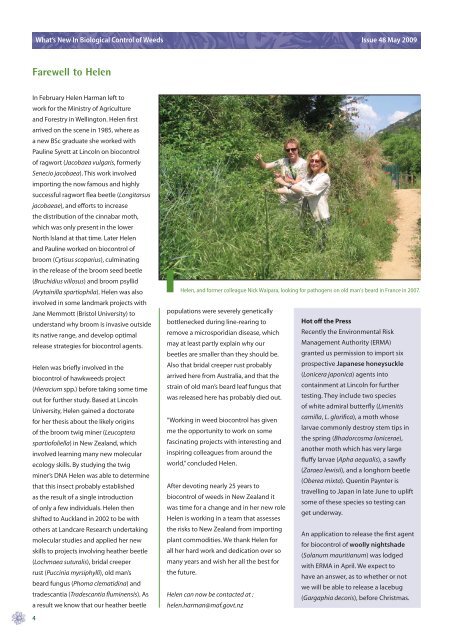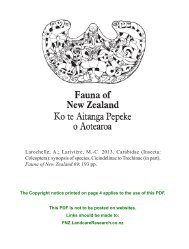PDF File, 693.8 KB - Landcare Research
PDF File, 693.8 KB - Landcare Research
PDF File, 693.8 KB - Landcare Research
Create successful ePaper yourself
Turn your PDF publications into a flip-book with our unique Google optimized e-Paper software.
4<br />
What’s New In Biological Control of Weeds<br />
Farewell to Helen<br />
In February Helen Harman left to<br />
work for the Ministry of Agriculture<br />
and Forestry in Wellington. Helen fi rst<br />
arrived on the scene in 1985, where as<br />
a new BSc graduate she worked with<br />
Pauline Syrett at Lincoln on biocontrol<br />
of ragwort (Jacobaea vulgaris, formerly<br />
Senecio jacobaea). This work involved<br />
importing the now famous and highly<br />
successful ragwort fl ea beetle (Longitarsus<br />
jacobaeae), and eff orts to increase<br />
the distribution of the cinnabar moth,<br />
which was only present in the lower<br />
North Island at that time. Later Helen<br />
and Pauline worked on biocontrol of<br />
broom (Cytisus scoparius), culminating<br />
in the release of the broom seed beetle<br />
(Bruchidius villosus) and broom psyllid<br />
(Arytainilla spartiophila). Helen was also<br />
involved in some landmark projects with<br />
Jane Memmott (Bristol University) to<br />
understand why broom is invasive outside<br />
its native range, and develop optimal<br />
release strategies for biocontrol agents.<br />
Helen was briefl y involved in the<br />
biocontrol of hawkweeds project<br />
(Hieracium spp.) before taking some time<br />
out for further study. Based at Lincoln<br />
University, Helen gained a doctorate<br />
for her thesis about the likely origins<br />
of the broom twig miner (Leucoptera<br />
spartiofoliella) in New Zealand, which<br />
involved learning many new molecular<br />
ecology skills. By studying the twig<br />
miner’s DNA Helen was able to determine<br />
that this insect probably established<br />
as the result of a single introduction<br />
of only a few individuals. Helen then<br />
shifted to Auckland in 2002 to be with<br />
others at <strong>Landcare</strong> <strong>Research</strong> undertaking<br />
molecular studies and applied her new<br />
skills to projects involving heather beetle<br />
(Lochmaea suturalis), bridal creeper<br />
rust (Puccinia myrsiphylli), old man’s<br />
beard fungus (Phoma clematidina) and<br />
tradescantia (Tradescantia fl uminensis). As<br />
a result we know that our heather beetle<br />
Issue 48 May 2009<br />
Helen, and former colleague Nick Waipara, looking for pathogens on old man’s beard in France in 2007.<br />
populations were severely genetically<br />
bottlenecked during line-rearing to<br />
remove a microsporidian disease, which<br />
may at least partly explain why our<br />
beetles are smaller than they should be.<br />
Also that bridal creeper rust probably<br />
arrived here from Australia, and that the<br />
strain of old man’s beard leaf fungus that<br />
was released here has probably died out.<br />
“Working in weed biocontrol has given<br />
me the opportunity to work on some<br />
fascinating projects with interesting and<br />
inspiring colleagues from around the<br />
world,” concluded Helen.<br />
After devoting nearly 25 years to<br />
biocontrol of weeds in New Zealand it<br />
was time for a change and in her new role<br />
Helen is working in a team that assesses<br />
the risks to New Zealand from importing<br />
plant commodities. We thank Helen for<br />
all her hard work and dedication over so<br />
many years and wish her all the best for<br />
the future.<br />
Helen can now be contacted at :<br />
helen.harman@maf.govt.nz<br />
Hot off the Press<br />
Recently the Environmental Risk<br />
Management Authority (ERMA)<br />
granted us permission to import six<br />
prospective Japanese honeysuckle<br />
(Lonicera japonica) agents into<br />
containment at Lincoln for further<br />
testing. They include two species<br />
of white admiral butterfl y (Limenitis<br />
camilla, L. glorifi ca), a moth whose<br />
larvae commonly destroy stem tips in<br />
the spring (Bhadorcosma lonicerae),<br />
another moth which has very large<br />
fl uff y larvae (Apha aequalis), a sawfl y<br />
(Zaraea lewisii), and a longhorn beetle<br />
(Oberea mixta). Quentin Paynter is<br />
travelling to Japan in late June to uplift<br />
some of these species so testing can<br />
get underway.<br />
An application to release the fi rst agent<br />
for biocontrol of woolly nightshade<br />
(Solanum mauritianum) was lodged<br />
with ERMA in April. We expect to<br />
have an answer, as to whether or not<br />
we will be able to release a lacebug<br />
(Gargaphia decoris), before Christmas.
















